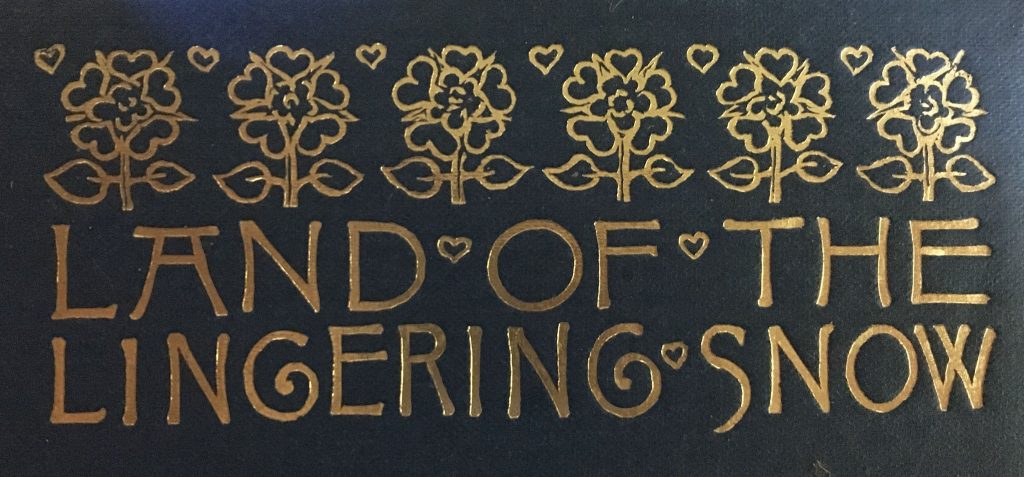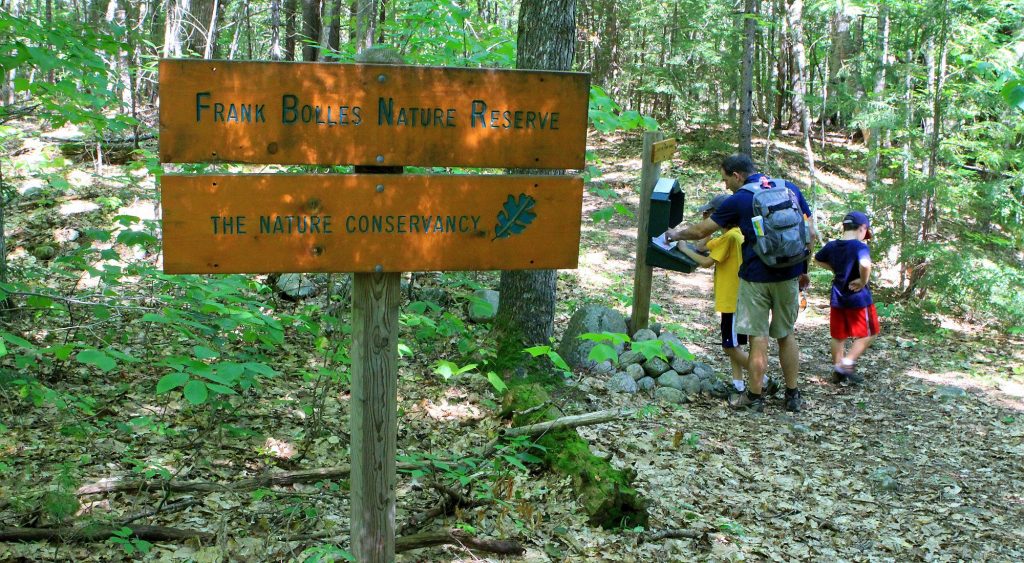
During nearly the whole of the forenoon of July 3, 1892, a soft rain had been falling. It had begun in the night to the discomfiture of the whippoorwills, but not to the extinguishment of their voices. It continued until nearly noon, when the wind shifted from east to west, patches of blue sky appeared, and ever and anon gleams of sunlight fell upon the distant forest across the lake, or slid slowly over the tree-tops on the side of Chocorua.
FRANK BOLLES’ FIRST BOOK, COVERED THE FIRST HALF OF A YEAR’S ROAMINGS IN NATURE, JANUARY THROUGH JUNE OF 1891. His second book, picks up the tale a year later, telling largely of his nature encounters between June and December of 1892. The lost year represents a considerable shift in Bolle’s world; no longer are his nature outings centered on the outskirts of Boston; instead, nearly the entire book (apart from a page or two at the very end) is set in the White Mountains of New Hampshire. Some time earlier, Bolles had purchased an old farmhouse with a red roof, on the shore of a heart-shaped lake, opposite the peak of Chocorua. Presumably his family accompanied him during most of his visits to New Hampshire, though he barely mentions them and never volunteers any names. Mostly, the book is filled with his rambles, along cascading mountain streams and up along the ridges of the mountains. Always there are the birds, which “calls for” (presumably using a call of an owl or another predator) and describes with much enthusiasm. In one “experiment”, Bolles spends from prior to sunrise through sunset watching a hollow snag beside a stream flowing into the lake, noticing all the birds that visit the area at various hours of the day.
FOR THE MOST PART, THE BOOK READS LIKE THE ACCOUNTS OF PLEASANT OUTINGS WITH A CHARMING FRIEND. Rarely does the writing soar poetically like Beston or Muir, and not often does Bolles stop to contemplate the “big picture” of the ecological relationships evident around him, or the nature of human impacts on the White Mountain landscape. Still, reading the book transported me back in time, back to an age of sawmills and logging camps, railroad timetables and hidden bear traps in the forest. As a means of escape — a time machine between navy blue cloth covers — the book was mostly a delight. Before I had even finished it, I went ahead and ordered the only other book of Bolles’ essays ever published, a posthumous collection of essays including four from a trip to Cape Breton (more about those in a later post). Only one essay troubled me; Bolles wrote about the forest “gnomes” (voles, shrews, and the like) and his campaign setting out deadly traps near his home to see what he could catch (and kill). For all his evident respect for birds, he seemed to have a different attitude toward small mammals — one that was no doubt in keeping with that of most Americans at the time.
FOUR PASSAGES IN THE BOOK CAUGHT MY EYE, FOR DIFFERENT REASONS; I WOULD LIKE TO SHARE THEM HERE. The first is in the opening essay, A Thunderstorm in the Forest. Walking through the deep woods in a storm, he interrupts his ornithological observations to appreciate the rain falling on the leaves of various plants:
The rain pelting into my eyes bade me look less at the sky and more at the beauties at my feet…. There were no flowers, but the leaves were enough to satisfy both eye and mind — large leaves and small, coarse and delicate, strong and feeble, stiff and drooping. Some were long and slender, others deeply cleft, some round, or smoothly oval, others shaped like arrow-heads. Some received the rain submissively and bowed more and more before it, others responded buoyantly as each drop struck them and was tossed off. In some the up-and-down motion communicated by the falling drop was by the formation of the leaf-stalk transformed at once into an odd vibration from side to side, which was like an indignant shaking of the head.
What I appreciate about this passage is that, instead of stopping at describing leaf shapes, Bolles notices how the plants interact with the raindrops; instead of a static scene, the woodland forest floor comes alive for a few sentences. And I am left wondering how the different plants where I live here in Georgia might respond to the falling rain….
THE SECOND PASSAGE IS A MOMENT OF COSMIC WONDER, REMINISCENT OF BESTON. For Beston, that wonder called forth the rich interconnectedness of all things in ever-flowing energy and changing form; for Bolles, it points instead toward evidence for the existence of a God:
There is something inexpressibly touching and inspiring in the combination of fading night, with its planets still glowing, and the bird’s song of welcome to the day. Night is more eloquent than day in telling of the wonders of the vast creation. Day tells less of distance, more of detail; less of peace, more of contest; less of immortality, more of the perishable. The sun, with its dazzling light and burning heat, hides from us the stars, and those still depths as yet without stars. It narrows our limit vision, and at the same time hurries us worries us with our own tasks which we will not take cheerfully, and the tasks of others which are done so ill. Night tells not only of repose on earth, but of life in that far heaven where every star is a thing of motion and a creation full of mystery. Men who live only in great cities may be pitied for being atheists, for they see little beyond the impurity of man; but it seems incredible that a being with thoughts above appetite, and imagination above lust, should live through a night in the wilderness, with the stars to tell him of space, the dark depths of the sky to tell him of infinity, and his own mind to tell him of individuality, and yet doubt that some Being more powerful and less fickle than himself is in the universe.
THE THIRD PASSAGE IS FROM THE CLOSE OF THE BOOK; AS IF PRESAGING HIS OWN DEATH ONLY A YEAR AFTER THE BOOK WAS PUBLISHED, BOLLES CLOSES HIS FINAL ESSAY WITH THOUGHTS ON MORTALITY. Bolles ended his first volume on a similar note, though here, it is rendered more potently, as if Bolles is endeavoring through images and analogues of nature to convince himself that there is existence beyond the grave. There is tragic irony to his musings here:
…years are very real to us who can count so few of them before we reach that wide ocean towards which our stream flows. The flower has a day in its year, the gnat an hour. What a mighty harvest death has reaped since year began; yet no one expects any shrinkage in the current of life in the next year. The world’s rhythm will be just as strong, just as even, just as full of joy to those who will accept joy as the birds accept it. What, then, is death if it cannot diminish the sum total of creation’s forces? Is it more than a transfer of energy from one point to another? When the flower dies we can see and measure the transfer; when a man dies we who live cannot see it at all, but we can measure the poor shell which is left to us and feel sure, terribly sure at first, joyously sure in time, that all which was there in life is not still there; that something has been transferred where we can neither see nor measure it.
I WILL CLOSE ON A BRIGHTER NOTE, WITH THE FOURTH AND FINAL PASSAGE THAT CAPTURED MY ATTENTION AS I READ THIS BOOK. I have never seen Frank Bolles quoted anywhere — I hadn’t even heard of him before embarking on this blog. Meanwhile there are millions of Thoreau quotes written everywhere — there are even books filled with Thoreau’s quotes on different subjects (I have one on Education). But if I were to happen upon a Frank Bolles quote someday, I suspect it might be this one:
If we are in tune with nature, all her music can find a way into the heart and satisfy something there which yearns for it, and never can be wholly happy without it.
FINALLY, A FEW WORDS ABOUT THE COPY OF THE BOOK I READ. I managed to obtain a book whose cover appears practically new — vibrant blue cloth not at all faded, no writing inside — not even a bookplate or owner’s name anywhere. The volume was published in 1896, and is indicated as a Third Edition. I am gratified to know that, for at least a few years, Bolles’ work had some degree of popularity. From other copies I have seen for sale online, I suspect that my edition was also the last.

